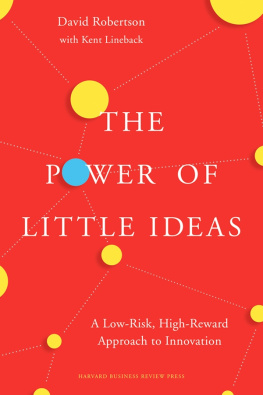David Robertson has done it again. The Power of Little Ideas draws on rich examplesfrom car sales to toy making to digital technologyto provide a powerful, practical approach to innovation resulting in sustainable success for the company.
STEPHEN K. KLASKO, MD, MBA, President and CEO, Thomas Jefferson University and Jefferson Health; coauthor, We CAN Fix Healthcare
David Robertson demonstrates a compelling new innovation space between incremental and radical innovations. This Third Way is an excellent new resource for innovation practitioners in any industry.
MICK SIMONELLI, former Lead Innovation Executive, USAA
This important book is packed with useful case studies, thoughtful advice, and a refreshingly clear-eyed view of how different forms of innovation work today. Its perfect for business leaders and managers who want to innovate in a more considered and realistic way for their business and brand.
TOM ANDREWS, President, SYPartners Consulting
THE
POWER OF
LITTLE IDEAS
David Robertson
with Kent Lineback
THE
POWER OF
LITTLE IDEAS
A Third Way to Innovate
for Market Success
Harvard Business Review Press
Boston, Massachusetts
HBR Press Quantity Sales Discounts
Harvard Business Review Press titles are available at significant quantity discounts when purchased in bulk for client gifts, sales promotions, and premiums. Special editions, including books with corporate logos, customized covers, and letters from the company or CEO printed in the front matter, as well as excerpts of existing books, can also be created in large quantities for special needs.
For details and discount information for both print and ebook formats, contact booksales@harvardbusiness.org, tel. 800-988-0886, or www.hbr.org/bulksales.
Copyright 2017 David C. Robertson
All rights reserved
No part of this publication may be reproduced, stored in or introduced into a retrieval system, or transmitted, in any form, or by any means (electronic, mechanical, photocopying, recording, or otherwise), without the prior permission of the publisher. Requests for permission should be directed to permissions@hbsp.harvard.edu, or mailed to Permissions, Harvard Business School Publishing, 60 Harvard Way, Boston, Massachusetts 02163.
The web addresses referenced in this book were live and correct at the time of the books publication but may be subject to change.
Library of Congress Cataloging-in-Publication Data
Names: Robertson, David C. (David Chandler), author. | Lineback, Kent, 1943- author.
Title: The power of little ideas : a low-risk, high-reward approach to innovation / by David C. Robertson with Kent Lineback.
Description: Boston, Massachusetts : Harvard Business Review Press, [2017]
Identifiers: LCCN 2016049137 | ISBN 9781633691681 (hardcover : alk. paper)
Subjects: LCSH: Technological innovations. | New products. | Management.
Classification: LCC HD45 .R595 2017 | DDC 658.4/063dc23 LC record available at https://lccn.loc.gov/2016049137
ISBN: 9781633691681
eISBN: 9781633691698
CONTENTS
Preface Seeing Innovation Differently | |
I wrote this book, at least in part, because of what I learned a few years ago from Stephen, the guy who painted my house. We hired Stephen and his crew because he had done great work on many neighbors houses. We werent disappointedhe did an excellent job on mine, and I would recommend him to anyone. He not only painted the house but also helped my wife and me decide which colors to use, fixed the gutters, and did many other small repairs around the house. But hiring Stephen and his crew also illustrated something about innovation and gave me yet another reason to write this book.
When Stephen submitted his estimate to me for the work, he told me he planned to use Sherwin-Williams paint. He explained that it was a good, high-quality paint, but also that he preferred Sherwin-Williams because of the service the company provided him. He told me how easy it was to work with Sherwin-Williams, how close the local Sherwin-Williams store was, how the salespeople would help us with color selections, and that the store gave him free same-day delivery if he ran out of paint or supplies.
I did a quick map search of Sherwin-Williams and was surprised by what I found. Within a five-minute drive of my house in suburban Philadelphia, there were five Sherwin-Williams paint stores (six, if you count one dedicated to automotive finishes). There are only three Starbucks cafs within the same distance.
I stopped by the Sherwin-Williams store in my neighborhood and met Tom, the Sherwin-Williams sales rep who works with Stephen, to understand why Stephen liked the company. Beyond the many locations and good-quality paint, Tom and others from Sherwin-Williams also support Stephen throughout the process. Tom will come out to the job site to help Stephen estimate the job. Hell help Stephen develop an accurate plan for each phase of the project, and hell help Stephen estimate how much labor and material will be needed at each stage. The rep will also check Stephens proposal to make sure that all the necessary materials and equipment are included, then make sure that the right amount of material is available when it is needed. Tom starts his day an hour before his store opens, because thats when his customersthe painting contractorsstart their days.
During the job, Tom allows Stephen to adjust the amount of paint as needed. For example, if Stephen buys 50 percent too much primer, he can return the unused cans for a full credit, and Sherwin-Williams will adjust the amount of finish-coat paint for the job, preventing waste and extra expense (while primer paint can usually be returned, custom colored paint for the finish coat cant). Tom will check the daily orders and suggest items that Stephen might have forgotten. At the end of the job, Tom will help Stephen write up an estimate for the next job (and, as any homeowner knows, theres always a next job).
As I looked around the Sherwin-Williams store, I saw the expected paint color displays and marketing brochures. Near the entrance was an offer for a color consultant to come to my house to help me choose paint colors. On the wall was a full range of brushes, tools, and gadgets to help painters. While I was waiting for Tom, the sales clerk showed me a device that makes it easy for painters to cover the bottom of their shoes when they come in the door, and she told me about a tool that automatically applied mud to drywall tape, reducing materials use and labor cost. Tom told me about the annual show he attends to learn about new devices, techniques, and products for painters. He explained the contractor program that rewards painters like Stephen with increasing discounts as the volume of business increases.
Sherwin-Williams is proud of the quality of its paint. But my house isnt covered with Sherwin-Williams paint because I thought the paint was better. In fact, the consumer ratings magazine I trust recommended a slightly higher-rated paint at half the price. But Stephen explained that only about 15 percent of the cost of a painting job was the paint itself, and if I wanted him to use a different paint, the cost of the project would be higher.
Sherwin-Williams isnt selling paint. Its selling a complete service to small painting companies like Stephens. It supports those small businesses with a complete end-to-end service, and its doing quite well in the process: sales in 2015 are up 46 percent over 2010, and profits are up 128 percent in the same period. The company is constantly innovating in its core productincluding a microbicidal paint that kills common bacteria like
Next page






